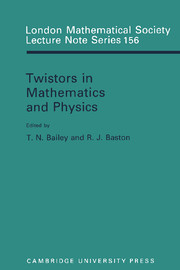Book contents
- Frontmatter
- Preface
- Contents
- 1 Twistor Theory After 25 Years—its Physical Status and Prospects
- 2 Between Integral Geometry and Twistors
- 3 Generalized Conformal Structures
- 4 Riemannian Twistor Spaces and Holonomy Groups
- 5 Twistors, Ambitwistors, and Conformal Gravity
- 6 The Penrose Transform
- 7 Notation for the Penrose Transform
- 8 The Twistor Transform
- 9 Invariant Operators
- 10 Penrose's Quasi-local Mass
- 11 The Sparling 3-form, Ashtekar Variables and Quasi-local Mass
- 12 Twistors and Strings
- 13 Integrable Systems in Twistor Theory
- 14 Twistor Characterization of Stationary Axisymmetric Solutions of Einstein's Equations
- 15 A Two-surface Encoding of Radiative Space-times
- 16 Twistors, Massless Fields and the Penrose Transform
- 17 Twistor Diagrams and Feynman Diagrams
- 18 Cohomology and Twistor Diagrams
- Authors' addresses
14 - Twistor Characterization of Stationary Axisymmetric Solutions of Einstein's Equations
Published online by Cambridge University Press: 05 May 2013
- Frontmatter
- Preface
- Contents
- 1 Twistor Theory After 25 Years—its Physical Status and Prospects
- 2 Between Integral Geometry and Twistors
- 3 Generalized Conformal Structures
- 4 Riemannian Twistor Spaces and Holonomy Groups
- 5 Twistors, Ambitwistors, and Conformal Gravity
- 6 The Penrose Transform
- 7 Notation for the Penrose Transform
- 8 The Twistor Transform
- 9 Invariant Operators
- 10 Penrose's Quasi-local Mass
- 11 The Sparling 3-form, Ashtekar Variables and Quasi-local Mass
- 12 Twistors and Strings
- 13 Integrable Systems in Twistor Theory
- 14 Twistor Characterization of Stationary Axisymmetric Solutions of Einstein's Equations
- 15 A Two-surface Encoding of Radiative Space-times
- 16 Twistors, Massless Fields and the Penrose Transform
- 17 Twistor Diagrams and Feynman Diagrams
- 18 Cohomology and Twistor Diagrams
- Authors' addresses
Summary
Introduction
One of the nonlinear systems that can be ‘solved’ by twistor methods is a reduced form of Einstein's vacuum equations for gravitational fields with two commuting Killing vectors. It is an intriguing example because it remains one of the central aims of twistor theory to tackle the full Einstein equations without any special assumptions about symmetry or self-duality. The solution of the reduced problem is a step towards achieving this. However, unlike the nonlinear graviton [11], which was based on a direct generalization of the familiar geometry of flat twistor space, the construction in this case is indirect and ungeometric. It was developed by Ward [18], who followed up Witten's observation [19] that the Ernst equation [3] is equivalent to a reduction of the self-dual Yang-Mills equations.
Ward's twistor analysis of stationary axisymmetric fields has been extended in two papers. The first (Woodhouse and Mason [21]) describes the connection with the solution generation techniques in relativity and uses twistor theory to ‘explain’ the occurrence of Riemann-Hilbert problems in the construction of exact solutions (the solution generation techniques are reviewed by Cosgrove [2] and in a collection of articles edited by Hoenselaers and Dietz [5]). The second (Woodhouse [20]) applies Ward's construction to gravitational waves with cylindrical symmetry.
The connection between the twistor geometry and the space-time geometry remains obscure and it is still possible that the construction reflects no more than an accidental correspondence between equations.
- Type
- Chapter
- Information
- Twistors in Mathematics and Physics , pp. 260 - 282Publisher: Cambridge University PressPrint publication year: 1990
- 2
- Cited by



